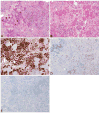The repertoire of somatic genetic alterations of acinic cell carcinomas of the breast: an exploratory, hypothesis-generating study
- PMID: 26011570
- PMCID: PMC5011405
- DOI: 10.1002/path.4566
The repertoire of somatic genetic alterations of acinic cell carcinomas of the breast: an exploratory, hypothesis-generating study
Abstract
Acinic cell carcinoma (ACC) of the breast is a rare form of triple-negative (that is, oestrogen receptor-negative, progesterone receptor-negative, HER2-negative) salivary gland-type tumour displaying serous acinar differentiation. Despite its triple-negative phenotype, breast ACCs are reported to have an indolent clinical behaviour. Here, we sought to define whether ACCs have a mutational repertoire distinct from that of other triple-negative breast cancers (TNBCs). DNA was extracted from microdissected formalin-fixed, paraffin-embedded sections of tumour and normal tissue from two pure and six mixed breast ACCs. Each tumour component of the mixed cases was microdissected separately. Tumour and normal samples were subjected to targeted capture massively parallel sequencing targeting all exons of 254 genes, including genes most frequently mutated in breast cancer and related to DNA repair. Selected somatic mutations were validated by targeted amplicon resequencing and Sanger sequencing. Akin to other forms of TNBC, the most frequently mutated gene found in breast ACCs was TP53 (one pure and six mixed cases). Additional somatic mutations affecting breast cancer-related genes found in ACCs included PIK3CA, MTOR, CTNNB1, BRCA1, ERBB4, ERBB3, INPP4B, and FGFR2. Copy number alteration analysis revealed complex patterns of gains and losses similar to those of common forms of TNBCs. Of the mixed cases analysed, identical somatic mutations were found in the acinic and the high-grade non-acinic components in two out of four cases analysed, providing evidence of their clonal relatedness. In conclusion, breast ACCs display the hallmark somatic genetic alterations found in high-grade forms of TNBC, including complex patterns of gene copy number alterations and recurrent TP53 mutations. Furthermore, we provide circumstantial genetic evidence to suggest that ACCs may constitute the substrate for the development of more aggressive forms of triple-negative disease.
Keywords: TP53; breast cancer; immunohistochemistry; massively parallel sequencing; triple-negative.
Copyright © 2015 Pathological Society of Great Britain and Ireland. Published by John Wiley & Sons, Ltd.
Conflict of interest statement
The authors have no conflicts of interest to declare.
Figures






References
-
- Foschini MP, Krausz T. Salivary gland-type tumors of the breast: a spectrum of benign and malignant tumors including “triple negative carcinomas” of low malignant potential. Semin Diagn Pathol. 2010;27:77–90. - PubMed
-
- Lakhani SR, Ellis IO, Schnitt SJ, et al. WHO classification of tumours of the breast. 4. IARC Press; Lyon: 2012.
-
- Damiani S, Pasquinelli G, Lamovec J, et al. Acinic cell carcinoma of the breast: an immunohistochemical and ultrastructural study. Virchows Arch. 2000;437:74–81. - PubMed
-
- Limite G, Di Micco R, Esposito E, et al. Acinic cell carcinoma of the breast: Review of the literature. Int J Surg. 2014;12S1:S35–S39. - PubMed
-
- Roncaroli F, Lamovec J, Zidar A, et al. Acinic cell-like carcinoma of the breast. Virchows Arch. 1996;429:69–74. - PubMed
Publication types
MeSH terms
Substances
Grants and funding
LinkOut - more resources
Full Text Sources
Other Literature Sources
Medical
Research Materials
Miscellaneous

